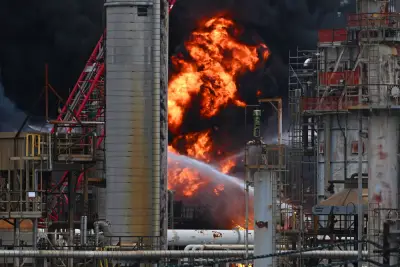Large Martinez refinery fire blamed on lack of contractor personnel, insufficient training and supervision

A February explosion and massive fire at a Martinez refinery happened because there were not enough number of contracted workers and insufficient training and supervision for those who were hired to do the work according to the draft analysis submitted to the county s physical condition department by a consultant Contractors also exceeded the timing of a work permit another reason the Feb blaze at the Martinez Refining Company began according to the account The refinery is located on Pacheco Avenue Related Articles One killed one injured six displaced in Berkeley apartment fire Alameda County DA dismisses matter against Radius Recycling in massive fire Father child safely rescued from Oakland apartment fire Brentwood City Council to discuss rejected downtown fire station next month Oakland firefighters rescue resident from burning apartment The fire sent a large plume of black smoke over Martinez Pacheco and Clyde and distributed more than gallons of hydrocarbon materials into the air according to the company s -day overview that was submitted to the county in March Nearby residents were ordered to shelter-in-place for more than four hours Six workers required medicinal therapy All of them were treated at the scene and distributed without being hospitalized according to that same review The chemicals issued in the fire included those that cause cancer heart and lung disorder according to the Contra Costa Vitality Services Department The company is owned by PBF Resource Inc and has faced much scrutiny in latest years In October the refinery issued petroleum coke dust on the city of Martinez It also leaked coke dust in July of that year and came under scrutiny on Thanksgiving when it leaked material containing aluminum barium chromium nickel vanadium and zinc in higher levels than are safe agents reported Consultant JEM Advisors prepared the latest analysis and presented it to the Contra Costa Robustness s Martinez Refining Company Oversight Committee on Tuesday According to the record the root cause of the fire was because operations monitoring and control of work was inadequate for the current contractor organizational capability That root cause was created by three underlying causes according to the overview Regulatory issues were the first contributing cause The account states that California Senate Bill requires contractor manpower to be sourced solely from the local union hall a requirement that made past guidance including those trained in professional shutdown execution no longer available As a outcome the refinery was short of manpower That factor came into play about p m on Feb when two contract workers began opening a flange to install an isolation blind to prepare for planned maintenance on one of the process units according to the description A flange is a protruded ridge in piping systems that provides a way to connect or disconnect pipes without welding thus making it easier to access for maintenance Contract workers mistakenly opened the wrong flange causing fuel to leak the review declared The hydrocarbon material ignited within a minute as the workers evacuated the area The examination concluded that that MRC procedures to positively identify work locations and to verify isolation and zero strength were not effective for the current Maintenance Contractor organizational capability resulting in the workers opening a flange on the wrong side of the isolation valve resulting in the loss of containment the summary stated The description also indicated that that the company s work processes and procedures led to the root cause According to the statement the MRC requires Permits to Work to be re-validated if the work has not started within minutes of the issuance This is supposed to ensure that safe work conditions still exist In this occurrence the work on the isolation blind started about hour minutes after the permit approval and the re-validation process didn t take place the statement revealed The small font of text also was part of the predicament because it made permits to work tough to read according to the assessment Human factors specifically the lack of contractor training was the third underlying cause the assessment explained The lack of a contract foreman impeded clear communications regarding job details and safety hazards and created a higher likelihood for human errors the assessment reported Inadequate contractor supervision was the fourth underlying cause listed in the record It summarized that supervisors did not have adequate knowledge of procedures requirements and standards Contractor supervisors often manage multiple crews in multiple locations and are not consistently on jobsites during potentially hazardous maintenance measures the review disclosed Even with ratios as low as supervisor to craftspeople they cannot be in two locations at the same time as bulk crew teams are two-person teams In the analysis JEM Advisors recommends the company increase its operations oversight for maintenance work and that it revises the PBF MRC Permit to Work form to include improvements including a larger font size The record stated that the company already had implemented particular of the recommendations prior to the analysis including increasing company presence during contractor maintenance work


